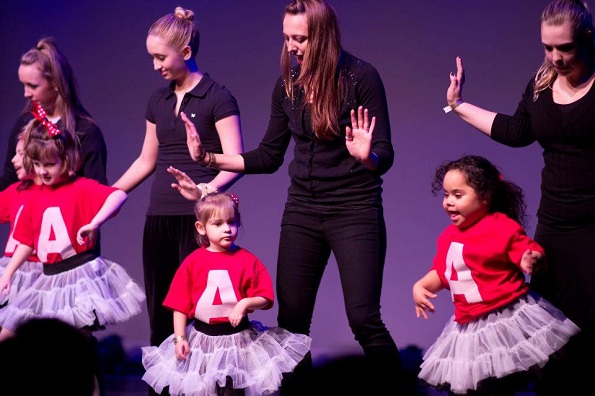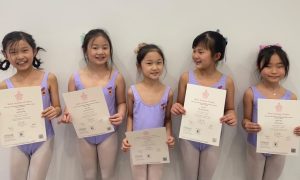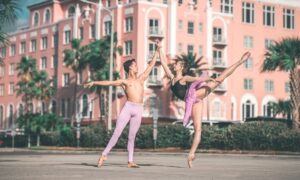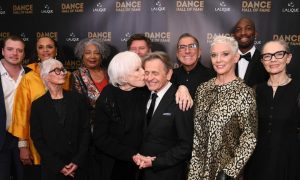By Chelsea Thomas.
In recent years, an increasing amount of dance studios have begun to offer classes and programs for special needs youth and adults with various forms of developmental and mental disabilities. Merging dance techniques with theatrical activities and therapeutic exercises, these classes are witnessing frequent physical, emotional and social improvements in the students involved.
As the field of dance therapy has grown in the last two decades, so has the appeal to incorporate a broader range of students in the dance studio. Three organizations across the country that are actively exemplifying this development are: The Ballet Academy of Arizona, The Georgia Ballet’s Dance-Ability program, and Merrimack Hall Performing Arts Center’s Johnny Stallings Arts Program in Huntsville, AL.
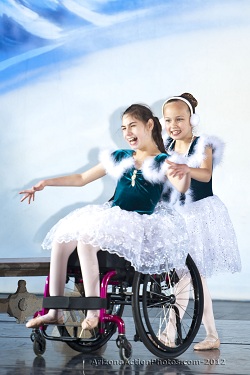
Ballet Academy of Arizona dancers perform
Caroline Atkinson, a 2012 Arizona Governor’s Arts Award Finalist, is certainly a pioneer in this dance sphere. The Founder, CEO and Artistic Director of the Ballet Academy of Arizona, a dance studio specializing in teaching special needs students, Atkinson has the education and expertise to speak to this field.
Atkinson holds diplomas in anatomy and kinesiology and child psychology and development, and is classically trained in both Cecchetti and Royal Academy of Dance (RAD) syllabi. A current tutor, mentor and practical teaching supervisor with RAD USA, she also has a wealth of experience to pull from, including teaching dance in Swaziland at an orphanage for 500 AIDS children and once leading 600 dance students at her ballet studio, Ballet Academy of Westport, CT, for 17 years.
“I have always worked with dancers with special needs, whether they have physical disabilities or emotional needs,” Atkinson says. “Drawing out the inner dancer and inner strength of the children and young adults that I work with is my passion and gift. Promoting the importance and acceptance of inclusion in our society is what I am trying to do.”
At Ballet Academy of Arizona, special needs students can participate in holistic dance classes, periodic group performances and inclusive community. Through these programs, dancers with any disability, whether it is Down syndrome, mental retardation, autism, cerebral palsy or even rare genetic disorders, can experience the joys of dance, movement and community.
Atkinson says that the programs set “high expectations of all dancers, promoting positive attitudes and behavior.” Classes select and use a range of learning styles appropriate to the learning outcomes and needs of all dancers, taking into account strategies for inclusion and differentiation.
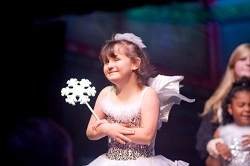
Dylan in ‘My Holiday Wish’ in ‘Dance Your Dreams!’ performance. Photo courtesy of Merrimack Hall.
“I also concentrate on working on fine and gross motor skills, sequencing, counting, musicality and complete music saturation, confidence, the knowledge that nothing is ever wrong when dancing, and above all, the joy of dance –whether the dancer is able to move or not,” Atkinson details.
In addition to teaching at the Ballet Academy of Arizona, Atkinson is also teaching in Charleston, SC and southern California, where she was awarded the 2011 Inclusive National Leadership Award from K.I.T. in San Diego. This year, she is excited to launch several more teaching locations within southern California, which will serve the “typical as well as the disability community.”
Likewise, Debra Jenkins, Co-Founder and Chairman of the Board at Merrimack Hall Performing Arts Center in Huntsville, AL, has seen a growing desire for special needs dance programs. Through a program called ‘Dance Your Dreams!’, youth with various disabilities can partake in quality dance instruction. The program launched its first class in October 2008 with nine girls and one boy aged 3-12 years. Now more than 40 students participate per semester.
“We conduct our classes exactly as you would any traditional dance class. We begin at the barre, move to the center for floor work, learn combinations and variations and make use of props such as exercise balls, hula hoops, scarves and others to stimulate our students’ participation in dance,” Jenkins says.
“Many of our kids are non-verbal, but they certainly know what to do when the music is turned on! Movement brings great joy to our students, particularly those who are immobile due to cerebral palsy.”
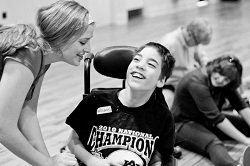
A dancer and volunteer interact at Camp Merrimack. Photo courtesy of Merrimack Hall
The Dance Your Dreams! program is also offered free of charge to its participants, with students even being provided class dance attire and costumes for performances. Each participant is also paired with a trained teenage volunteer, or a “coach,” who offers whatever level of assistance students require.
“Our volunteers are recruited from local dance studios, high school theatre and choir groups, service clubs and others. Coaches are provided with training at the beginning of each year and are asked to commit to one semester at a time, “ Jenkins explains. “By pairing the kids one-to-one with assistance, and limiting our class size to 10, we are able to offer quality dance instruction to children with a variety of disabilities, including Down syndrome, autism spectrum disorders, cerebral palsy, cancer and a host of other debilitating conditions.”
Similarly, a newer program on the national radar, The Georgia Ballet’s Dance-Ability program, utilizes teaching assistants who enable dancers and provide one-on-one attention. Rebecca Geiger, Arts in Education Associate at The Georgia Ballet, has established the program as a 12-week class designed for students with special needs, ages 6 and up.
“I tailor the class to the different abilities of each dancer and I rely heavily on my volunteers to be able to push each dancer to achieve his or her potential,” Geiger says. “I look to strengthen muscles, reinforce neuromuscular control, increase balance, coordination and motor planning, develop vestibular input and strengthen social skills.”
Some ways Geiger does this is by teaching basic ballet positions and steps, and working on jumping, galloping, walking on tiptoes and remembering choreography. Her background as a certified therapist is able to help her tailor the class to the different abilities of each dancer.
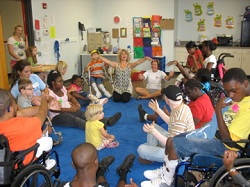
Classes at Ballet Academy of Arizona
“I have to be ready to adjust my expectation to each child in terms of what steps they will be able to master and to what degree they can perform them correctly. I also have to be a lot more tolerant of talking to another person in the class since social skills are difficult to understand for some,” she says.
Yet, for all the additional work and preparation that go into planning and leading special needs dance classes, the reward is multiplied. Jenkins shared numerous stories of dancers improving motor and social skills.
“We have one student, Amelia, who started with us at age six completely confined to a wheelchair. Today, Amelia not only walks, but she can chasse across the floor,” Jenkins exclaims. “Amelia is profoundly developmentally disabled, wears cochlear implants and is non-verbal, but she takes to the stage like a pro at our frequent performance opportunities. Her mother and physical therapist are convinced the only reason Amelia is walking today is because of her participation in dance.”
Jenkins adds, “We have testimonials from physicians and physical therapists stating that our students have made great improvement in their core strength, agility, balance and even in their social and communication development because of their participation in dance.”
Overall, in talks with many teachers, instructors and volunteers, one consistent outcome of special needs dance classes and performances was evident – inspiration for all involved.
“I have learned more in the past five years from people who our society tells us are ‘less than’ than I’ve ever learned from anyone who is ‘normal’. And I’ve learned that it’s through the arts that we are able to express our humanity, regardless of the level of our performance,” Jenkins says.
“One of our students, Abbey, is 13 and has cerebral palsy. Smart as a whip, Abbey has suffered through multiple surgeries, wears hearing aids, is visually impaired and walks with great difficulty. But her indomitable spirit is contagious, as is her love of dance. This summer, Abbey shared this wisdom with me. She said, ‘I’ve decided that everyone has special needs and that we all have two special needs in common. We all have the need to be loved and we all have the need to be accepted. Some people’s special needs are on the outside, like mine. And some people’s special needs are on the inside.’ She went on to say that when she’s dancing at Merrimack Hall, ‘I feel beautiful and graceful no matter what anyone else says.’”
For more information on these programs, visit the links below:
- Ballet Academy of Arizona: www.balletacademyofarizona.org
- The Georgia Ballet’s Dance-Ability: www.georgiaballet.org
- Merrimack Hall’s ‘Dance Your Dreams!’: www.merrimackhall.com
Project UP (a performing company for teens with special needs) traveled to Atlanta in January to compete at NRG Dance Project. They performed Waiting on the World to Change, a piece about bullying, acceptance, and loving everyone regardless of our differences.
Photo (top): Dancers performing at ‘Dance Your Dreams!’ Eve of Dance, courtesy of Merrimack Hall.


